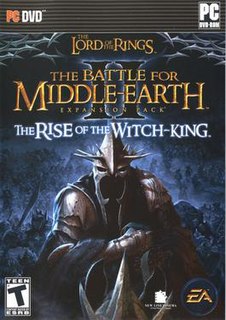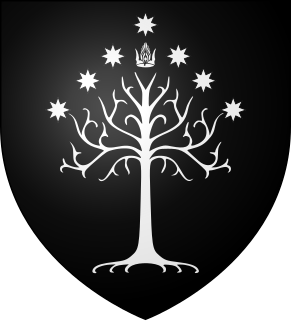Anárion is a fictional character in J. R. R. Tolkien's Middle-earth legendarium. His name is derived from Anar, which means "Sun" in Tolkien's invented language of Quenya. He was the son of Elendil and the brother of Isildur, and with them established the Realms in Exile in Middle-earth after the downfall of Númenor.

Angmar is a fictional kingdom in J. R. R. Tolkien's continent of Middle-earth, at the north end of the Misty Mountains. It was used by the Lord of the Ringwraiths as a base from which to attack the kingdoms of the Dúnedain in the North, all of which were eventually destroyed. Angmar itself was subsequently destroyed by combined armies of men and elves shortly thereafter.
Pelendur is a fictional character in J. R. R. Tolkien's Lord of the Rings, appearing The Return of the King.

According to J. R. R. Tolkien's legendarium of Middle-earth, the Stewards of Gondor – also styled the Lords of Minas Tirith – were lords of the fictional kingdom of Gondor, who resided in Minas Tirith, the capital city. The Steward was appointed by the King, and could act on behalf of the King when the King was absent from the city or incapacitated.
In the fantasy writings of J. R. R. Tolkien, Weathertop is a hill in Eriador, a region of Middle-earth. It is the southernmost and highest summit of the Weather Hills. The hill itself is of great importance in the history of Middle-earth, as chronicled in The Lord of the Rings, since it was a major fortress of the kingdom of Arthedain, home to one of the seven palantíri, and the site of several battles.
Arvedui is a fictional character from J. R. R. Tolkien's Middle-earth legendarium, who was the last King of Arnor before its destruction.
In J.R.R. Tolkien's Middle-earth legendarium, Malbeth the Seer was a sage of Arthedain who was remembered for two prophecies.
In the literary works of J. R. R. Tolkien the House of Anárion was the Royal House of Gondor, descended from Anárion, joint first King of Gondor with his elder brother Isildur who went north to Arnor. When the last King of Gondor died without an heir, the Stewards of the House of Húrin ruled in their stead for the next 969 years until the House of Elendil successfully reclaimed the Throne after the War of the Ring.
In the literary works of J. R. R. Tolkien, the House of Isildur was the Royal House of Arnor, Arthedain, Cardolan, Rhudaur and, much later, Gondor. The house was descended from Isildur, elder son and heir of Elendil the Faithful. Although the North-Kingdom was ended in the year 1975 of the Third Age, the House of Isildur was maintained as the Chieftains of the Dúnedain, the wandering folk that the Dúnedain of Arnor became, until the time of Aragorn II and the War of the Ring, after which, Aragorn claimed the Crown of Gondor as the direct descendant of Elendil. After Aragorn, the House of Isildur became the House of Telcontar and ruled the Reunited Kingdom for generations.
It was the pride and wonder of the Northern Line that, though their power departed and their people dwindled, through all the many generations the succession was unbroken from father to son. ... But in Aragorn the dignity of the kings of old was restored
In J.R.R. Tolkien's Middle-earth, the High Kings of Arnor and Gondor were the Kings of all Dúnedain in Middle-earth after the Downfall of Númenor. Elendil was the leader of the Elendili who survived the Downfall. He claimed the title of High King.
J. R. R. Tolkien adopted the term Northmen in his fiction; his "Northmen" were Men that lived in northern Wilderland in Middle-earth, and were friendly to Gondor.

The Lord of the Rings: The Battle for Middle-earth II: The Rise of the Witch-king is a real-time strategy video game published by Electronic Arts, based on the Lord of the Rings film series based on the book, directed by Peter Jackson. The Rise of the Witch-king is the official expansion to The Lord of the Rings: The Battle for Middle-earth II, which was published by the same company and released in 2006, for Microsoft Windows. The Rise of the Witch-king was shipped to stores in the United States on November 28, 2006 and was officially released on November 30, 2006.
In J. R. R. Tolkien's legendarium, the Dúnedain were a race of Men descended from the Númenóreans who survived the sinking of their island kingdom and came to Eriador in Middle-earth, led by Elendil and his sons, Isildur and Anárion. They are also called the Men of the West and the Men of Westernesse. They settled mainly in Arnor and Gondor.
The Witch-king of Angmar, also known as the Lord of the Nazgûl and the Black Captain, is a character in Tolkien's legendarium. In J. R. R. Tolkien's The Lord of the Rings, he is the chief of the Nazgûl or "Ringwraiths", the chief servants of the Dark Lord, Sauron. His name is not revealed in any of Tolkien's writings, nor are the names of any of the other Nazgûl except Khamûl.






